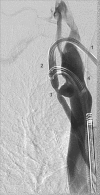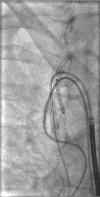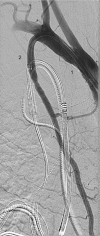Fistula from right internal mammary artery to superior vena cava after use of a laser sheath to extract a pacemaker lead
- PMID: 23109780
- PMCID: PMC3461661
Fistula from right internal mammary artery to superior vena cava after use of a laser sheath to extract a pacemaker lead
Abstract
A 55-year-old woman presented with dyspnea on exertion due to a right internal mammary artery-to-superior vena cava arteriovenous fistula that occurred after pacemaker lead extraction with a laser sheath. The fistula was successfully repaired by placing a covered stent in the right internal mammary artery. In this unusual location, endovascular stenting is a reasonable alternative to coil embolization or surgical repair of an arteriovenous fistula resulting from laser lead extraction.
Keywords: Arteriovenous fistula/etiology/therapy; blood vessel prosthesis/implantation; defibrillators, implantable; device removal/adverse effects/methods; electrodes, implanted; iatrogenic disease; laser therapy; lasers, excimer/adverse effects; mammary artery, right internal; pacemaker, artificial; stent-graft; vena cava, superior.
Figures




References
-
- Bongiorni MG, Soldati E, Zucchelli G, Di Cori A, Segreti L, De Lucia R, et al. Transvenous removal of pacing and implantable cardiac defibrillating leads using single sheath mechanical dilatation and multiple venous approaches: high success rate and safety in more than 2000 leads. Eur Heart J 2008;29(23):2886–93. - PMC - PubMed
-
- Byrd CL, Wilkoff BL, Love CJ, Sellers TD, Reiser C. Clinical study of the laser sheath for lead extraction: the total experience in the United States. Pacing Clin Electrophysiol 2002;25 (5):804–8. - PubMed
-
- Roux JF, Page P, Dubuc M, Thibault B, Guerra PG, Macle L, et al. Laser lead extraction: predictors of success and complications. Pacing Clin Electrophysiol 2007;30(2):214–20. - PubMed
-
- Wilkoff BL, Byrd CL, Love CJ, Hayes DL, Sellers TD, Schaerf R, et al. Pacemaker lead extraction with the laser sheath: results of the pacing lead extraction with the excimer sheath (PLEXES) trial. J Am Coll Cardiol 1999;33(6):1671–6. - PubMed
-
- Kumins NH, Tober JC, Love CJ, Culbertson TA, Gerhardt MA, Irwin RJ, Smead WL. Arteriovenous fistulae complicating cardiac pacemaker lead extraction: recognition, evaluation, and management. J Vasc Surg 2000;32(6):1225–8. - PubMed
Publication types
MeSH terms
LinkOut - more resources
Full Text Sources
Medical
